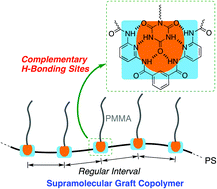Periodic introduction of a Hamilton receptor into a polystyrene backbone for a supramolecular graft copolymer with regular intervals†
Abstract
The Hamilton receptor group (–DADDAD–; D = hydrogen donor; A = hydrogen acceptor) was periodically introduced into a polystyrene backbone, starting from the ruthenium-catalyzed living radical polymerization of styrene with the Hamilton receptor-based bifunctional initiator. The carbon–halogen bonds at both terminals of the resultant unimodal polystyrene (PSDADDAD) carrying the –DADDAD– units at the center position were activated with a ruthenium catalyst to promote the radical–radical coupling reaction between chains, and thereby –DADDAD– units were multiply introduced into the polymer backbone with regular intervals [(PSDADDAD)n]. Upon mixing of the polymer with the end-functionalized poly(methyl methacrylate) (PMMA) carrying a “complementary” hydrogen bonding site (ADADA: PMMAADADA) in CDCl3, supramolecular graft copolymers were formed through the complementary hydrogen bonding between the terminal ADADA site of the guest polymers and the DADDAD site at the periodic positions in the polystyrene backbone. The differential scanning calorimetry (DSC) analysis showed the influence of periodicity in the grafting arm positions on the enthalpic transition of the supramolecular copolymers.


 Please wait while we load your content...
Please wait while we load your content...